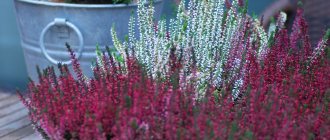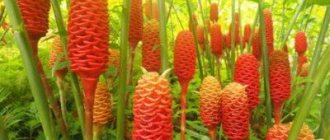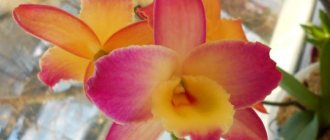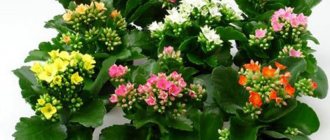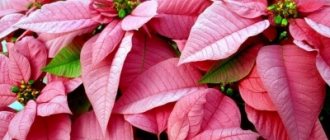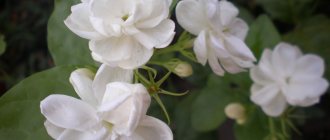Despite their poisonousness, capriciousness and extreme sensitivity, brunfelsias of all types and varieties in the West are considered one of the most fashionable flowering crops. This exotic beauty is sometimes called a competitor to violets, or their tropical replacement. But one thing is certain: brunfelsia is truly a profusely flowering and graceful plant. Beautiful and very bright foliage, simple and touching brunfelsia flowers can become the main decoration of the interior. But to enjoy the beauty of a unique plant, you will have to make a lot of effort.
The expressive appearance of the capricious Brunfelsia
Brunfelsia (Brunfelsia) is a fairly large genus of beautifully flowering herbaceous perennials with evergreen leaves and similar flowering, individual species of which differ only in the size of the bushes and growth forms. The main advantage of the plant is its colorful flowering, limited only by a cold palette of colors. Among gardeners around the world, brunfelsias are known as “Morning-day-night” (or “Yesterday-today-tomorrow”) for the ability of flowers to change colors. These exotic crops belong to the Solanaceae family and are the closest relatives of eggplants and tomatoes.
Brunfelsia pauciflora. © Steve Slater
The bushy and somewhat sloppy plant on sale is represented by modest and compact crumbs - bushes from 15 to 35 cm in height. But in indoor conditions, brunfelsia, unlike flower centers, is not treated with growth inhibitors and it quickly catches up, becoming hardly bulky. This is a lush and sprawling, far from compact crop, exceeding 50 cm in height with age and turning into a tree or bush without proper control.
Brunfelsia has very beautiful leaves. Leathery, large, they are painted in a bright and cool shade of dark green, which seems surprisingly fresh in the interior. Pointed at the ends, oval-elongated leaves are not densely arranged, alternately, sit on short petioles, but create a lush crown.
It is not for nothing that this culture is considered one of the beautifully flowering indoor stars. Brunfelsia flowers are very similar to gentians. The wide-open, simple tubular flowers appear elegant and modest, but the contrast with the leaves makes them surprisingly striking. They reach 5 cm in diameter and are often collected in small inflorescences of up to 10 flowers each. Brunfelsia begins to bloom when even the winter stars are already finishing their parade - in February. This charming exotic blooms with flowers from late winter to late spring, and sometimes in the first month of summer, and then gives way to other plants with more typical timing.
Brunfelsia grandiflora. © Alejandro Bayer
The color range of brunfelsias includes cool shades of the white and blue spectrum. Most varieties are colored blue and purple, but there are also varieties with white, yellow, and purple colors. A distinctive feature of brunfelsias is the loss of bright original color over time. The purple, blue, lilac flowers of the plant turn white after a couple of days. Since they bloom in waves, unevenly, flowers of different colors can be observed on the plant, which only adds to the charm of brunfelsia. The most common brunfelsias are odorless, but rare large species have a strong pleasant aroma, delicately spring-like and quite sweet.
Types and varieties of Brunfelsia with photos and names
Several species and varieties of plants are grown indoors.
Brunfelsia pauciflora
Brunfelsia pauciflora 'Floribunda' photo
The most popular type. Less capricious to care for, the bush lends itself well to shaping.
Species and varietal diversity of Brunfelsias
Today, in indoor culture, one type of Brunfelsia is most widespread - the few-flowered one (Brunfelsia pauciflora). Compact, easy to mold and less capricious, it adapts better to indoor conditions and is more durable. It is her appearance that is considered typical for brunfelsias. Many attractive varieties have been bred on the basis of the few-flowered Brunfelsia:
- dark purple form of “Makranta” with flowers up to 8 cm in diameter;
- light purple form "Floribunda" with a white eye;
- purple-flowered variety 'Eximia'.
In addition to the few-flowered species, larger species are occasionally found on sale:
- Brunfelsia uniflora (Brunfelsia uniflora) with large, up to 10 cm long leaves and single, up to 2.5 m flowers, changing from purple to blue and white;
- Brunfelsia latifolia with short, wide, matte leaves and very large, but not very elegant flowers;
- “night beauty” Brunfelsia americana with light oval leaves and cream flowers with a small corolla and a long tube, the aroma of which becomes very intense in the evenings and nights.
Growing brunfelsia is quite difficult. This is a plant for experienced gardeners who can provide Brunfelsia with constant care and a quick response to any developmental disturbances. All difficulties with this crop are associated primarily with the need to stimulate flowering in cool conditions and the plant’s extreme intolerance to any changes. This exotic beauty needs stable lighting and temperatures, and meticulous care.
Brunfelsia pauciflora. © plantsrescue
How to properly care for brunfelsia
Like any plant, Brunfelsia has certain rules of care so that the plant grows well, blooms and pleases its owner.
Creating favorable conditions
Watering
Regular watering is needed, but you cannot overwater it so that there is excess moisture in the pan, especially in winter; acidic soil is preferable for the plant, so you can acidify the water.
Since Brunfelsia comes from tropical forests, it is necessary to ensure sufficient humidity in the room. In winter, watering once a week is sufficient; the main thing is not to allow the soil to dry out or become waterlogged to prevent rotting of the roots.
Top dressing
For healthy growth and development, brunfelsia needs to be fed with nitrogen fertilizers twice a month to prevent the disease chlorosis .
Trimming
After the plant has flowered, you need to prune the plant to prevent the branches from being exposed. After pruning, the plant will have a compact appearance, and the fluffy branches with new and healthy foliage will soon bloom and bear seeds.
In the summer, brunfelsia should be taken out onto the balcony, into the fresh air. The main thing is that the temperature at night does not drop below 15 degrees, otherwise the plant will not bloom.
Lighting and temperature
The lighting should be diffused, then the tropical plant will have fleshy, healthy leaves and bright flowers with a pleasant aroma.
For maintaining the plant, the optimal temperature will be 21-23 degrees when Brunfelsia blooms, and up to 15 degrees during dormancy. The rest period after flowering lasts for two months.
The soil
In order to plant brunfelsia, it is advisable to make the following mixture: 1 part sand, two parts garden soil, two parts leaf humus. You can add peat to the mixture, this will be the best option for the growth and development of the plant.
To grow at home, you need a pot with a wide bottom for its fibrous root system, and drainage is also important.
Reproduction
Reproduction in Brunfelsia occurs using cuttings. Cuttings can be taken in spring or autumn, except during the flowering period.
Reproduction can also be done using root shoots. It is difficult to grow Brunfelsia using seeds and requires a lot of effort from the gardener.
Types of Brunfelsia
What types of home cultivation are most suitable? Brunfelsia pauciflora are suitable for cultivation .
Brunfelsia flowers are bluish with purple and lilac honey fungus.
Flowering begins in early spring, and new flowers appear until autumn. New flowers last for three days; during the flowering period the plant is very bright and beautiful.
Brunfelsia can be divided into the following types:
M almond-flowered - is a small bush. When favorable conditions are created, it can bloom all year round, sometimes due to abundant flowering the leaves are not visible;
Large-flowered brunfelsia, or otherwise grandiflora . It blooms very beautifully from early spring to autumn and has fragrant large tubular flowers. In a few days it can change the color of flowers from purple to white;
Australian brunfelsia is more suitable for growing in gardens where there is a lot of space. The plant itself is small in size, and the flowers are large, can be up to six centimeters in diameter;
Brunfelsia americana , or otherwise called night beauty, since it is at night that the plant develops a persistent and tasty aroma. The flowers change from white to cream, and at the very end of flowering they turn yellow;
Densely flowered brunfelsia is rarely used for artificial propagation. It has long and narrow leaves, and the flowers seem to hang on thin threads. The flowers are large, when open their diameter is up to 13 centimeters. This is a species with a strong aroma, the petals can be creamy white, yellow.
It is very important to know that all parts of this plant are poisonous, both fruits and seeds, so children and animals should not be allowed near it.
Lighting for Brunfelsia
Despite being a capricious plant, brunfelsia is able to adapt and bloom beautifully in sometimes different conditions. This is a light-loving plant that tolerates partial shade well, but only in one case: if the lighting does not change, remaining stable throughout the year. In typical indoor conditions for brunfelsia, it is better to provide a bright, but not too brightly lit place without direct sunlight. The classic location for brunfelsia is eastern or western window sills and shaded areas on southern window sills.
With the arrival of autumn, brunfelsia must be moved to a more illuminated place. The plant is displayed either on southern windowsills or in the brightest places in the east and west. For Brunfelsia, you can partially use artificial lighting.
Possible problems during cultivation
This capricious plant does not do well with a lack of attention. Pests can seriously spoil its appearance and even lead to death.
Diseases
Diseases bypass brunfelsia - it is immune to them. All problems arise only from poor care:
- violation of dormant conditions - it is necessary to normalize the amount and frequency of watering;
- improper lighting - avoid direct sunlight;
- presence of drafts - the plant should be in a quiet place;
- watering conditions and air humidity - follow the watering regime and place containers with water near the pet.
The main disease may be chlorosis, in which the formation of chlorophyll decreases and the leaves become yellow or pale. This disease is caused by a violation of the irrigation regime or increased acidity of the substrate.
Video: Everything you need to know about Brunfelsia
Temperature conditions for brunfelsia
From the beginning of spring until the arrival of autumn, Brunfelsia is similar in its requirements to all other indoor crops. It will feel great at normal room temperatures, but will achieve its greatest effectiveness if temperatures remain within the range of 16 to 18 degrees Celsius (in summer, the permissible values increase to 20-22 degrees Celsius). Brunfelsia does not like heat; too high air temperatures, even with appropriate measures to increase humidity, can still lead to the shedding of not only leaves, but also buds.
With the arrival of October, flowering needs to be stimulated. And there is only one way to do this - lower the temperature to the range from 9 to 14 degrees. Keeping it cool in October and November will encourage buds to open and flowering to begin. The total duration of the “cold period” should be 8 weeks (brunfelsia cannot be kept in the cold for longer than 12 weeks). A decrease in temperature should be accompanied by maintaining the usual level of lighting and moving to more illuminated places. At this stage you need to be careful: if brunfelsia is left in warm conditions, the plant will not show that it is uncomfortable and will look attractive. But later the brunfelsia will not only not bloom, but will also shed its leaves.
Brunfelsia latifolia. © Izu navi
The change of conditions must be carried out gradually, slowly. Brunfelsias do not tolerate constant fluctuations in air temperature or drafts, especially cold ones.
Brunfelsia flower Care at home Reproduction by cuttings Transplantation and pruning
Brunfelsia is a shrub or tree belonging to the Solanaceae family.
In the natural environment it reaches a height of 3 m, but when grown indoors it is limited to a height of about 0.5 m. The bush is spreading and lush. A pretty plant, Brunfelsia is called a tropical replacement for violets. The main advantage of brunfelsia is its colorful flowering. The flowers are similar to gentian. The tubular flowers are wide open, reach a diameter of 5 cm. They are collected in inflorescences of about 10 pieces. The color is cool white-blue, lilac, blue, yellow tones. Gardeners call the plant “yesterday-today-tomorrow” or “morning-day-night” because the initially colored corolla turns white.
Bloom
Brunfelsia americana in a pot
Flowers open unevenly, in waves, so flowers of different colors are simultaneously present on one plant. In most species, the flowers are odorless, and in some they exude a sweetish, delicate spring-like aroma. Flowering begins in February and lasts until the end of spring. The inflorescences, touching in their simplicity, instill a romantic mood.
The leaves are also decorative. They are oval-elongated in shape with pointed tips, leathery, and the color varies from bright to dark green. The leaf plates are attached alternately on short petioles, creating a lush crown.
Dangerous Beauty
Brunfelsia is poisonous - avoid getting the plant juice on your skin. To admire the graceful plant, you should make an effort, since the sweet beauty is capricious in its care.
Brunfelsia in the garden
Brunfelsia is widely grown in countries with warm climates as an ornamental shrub and hedge, but unfortunately, it does not winter in the middle zone, withstanding only a short-term drop in temperature to -1°C. Therefore, we can only enjoy the crazy flowering of bushes in apartment conditions. However, many flower growers have thought of planting plants in spacious tubs and taking them out to verandas or gazebos in the summer, decorating recreation areas in the country or in the garden.
Watering and humidity for Brunfelsia
This plant’s love for stable growing conditions is fully manifested in its requirements for watering procedures. The substrate in Brunfelsia pots should remain constantly moist, but without excess water. If watering is not regular, and the soil is even slightly dry or waterlogged, brunfelsia will begin to shed flower buds and instantly react by losing its decorative appearance. That is why for brunfelsia you need to build a watering system, choosing the ideal frequency by trial and error: between procedures, only the top layer of the substrate should dry out, no deeper than 2-3 cm. In summer, brunfelsia is usually watered 2-3 times a week. As temperatures drop, to stimulate flowering, watering should be reduced in accordance with the change in the rate of drying of the substrate, but under no circumstances should the soil clod be allowed to dry out.
A vital condition for the normal development of the plant is to ensure high air humidity. Brunfelsia loves frequent spraying, but spraying alone is not enough to create stable conditions. Yes, and during flowering it cannot be done. For this culture, it is better to take additional measures - install humidifiers or trays with moss and pebbles.
Plant diseases
Sometimes brunfelsia pleases with its painful appearance.
- Brunfelsia often suffers from leaf chlorosis , which indicates too hard water.
- Buds fall off - dry air or insufficient watering.
- The plant does not bloom - there is no dormant period.
- Leaves fall off - drying out or waterlogging of the soil.
- The leaves turn yellow - direct rays of the sun on a south window or a lack of microelements.
Fertilizing for brunfelsia
Despite the rather long flowering period, brunfelsias are fed moderately. They cannot tolerate an excess of nutrients almost as much as they cannot tolerate a deficiency. Feeding is carried out throughout the year, even during the dormant period and stimulating flowering. But from November to February, fertilizers are applied rarely and in reduced doses (every 3-4 weeks with a half or three times smaller dose of conventional mixtures or ammonium nitrate every 3 days at a concentration of 1.5 g per 1 liter of water). During the period of active growth (during the warm season), fertilizers are applied every two weeks.
Brunfelsia uniflora. © B.navez
For Brunfelsia, it is better to use complex fertilizers for flowering plants rather than universal mixtures.
Brunfelsia americana, lactea and other species for indoor growing
| View | Leaf shape and size | Flowers |
| Americana | Ellipse up to 10 cm in length. | Creamy, aromatic, tube length up to 10 cm. |
| False-flowered | Oval up to 10 cm in length. | White, purple, no aroma. |
| Large-flowered | Oval, pointed. | White, purple with a diameter of up to 12 cm. |
| Uniflora | Oval up to 10 cm. | White, purple, up to 2.5 cm in diameter. |
| Dairy (lactea) | Oval, 5 cm long. | White, light yellow, fragrant, 5-7 cm long. |
Brunfelsia transplant
Brunfelsia can be replanted only after flowering, when the plant is at the stage of complete dormancy. It is better to change the substrate and container only when necessary - the first signs of a lack of free soil. Young bushes are replanted annually, adults - no more than once every 2-3 years. When transplanting, it is necessary to lay a thick layer of drainage.
Substrate: slightly sour or sour, loose and fertile soil mixtures are suitable for brunfelsia. This culture grows very well in a substrate consisting of equal parts of leaf, turf, coniferous soil and sand. Brunfelsias will respond with gratitude to the addition of bone bunches.
Containers: the size of the containers is critical for Brunfelsia, which should be only a few centimeters larger than the previous pot, as well as the presence of a high-quality drainage hole.
Care and cultivation of brunfelsia
In relation to growing conditions, the plant cannot be called too capricious or picky. But if you want to grow a truly beautiful and spectacular plant, then you will have to pay a lot of attention to it.
Brunfelsia does not have any special requirements for soil and can grow equally well on neutral, slightly acidic and even alkaline (some types) soils. The structure of the substrate should be of medium density, while being sufficiently nutritious and well-drained. A soil mixture composed of turf soil, leaf humus, peat and river sand in a ratio of 2:2:1:1 or equal parts of leaf, turf and coniferous soil with the addition of sand is quite suitable for such requirements.
The pot is selected in accordance with the volume of the root system, and the plant’s root system is fibrous, requiring a wide container. Before planting, the bottom of the pot is filled with a drainage layer.
In their natural habitats, all brunfelsia species, with the exception of one, grow in the forest in sparse shade or partial shade. Therefore, in indoor culture it is capable of blooming even in those rooms where direct sunlight does not reach it at all. But in a bright room the flowering will be more magnificent. In open ground conditions and on southern windows, the plant needs to be shaded from too bright sun.
Like all tropical plants, Brunfelsia is thermophilic. The room temperature during the period of active growth and flowering should be about +22 degrees Celsius. Periods of rest are expressed differently in different species. For those that come from the subtropics, it is necessary to provide cooler conditions in winter - 10-12 degrees Celsius, and for typical representatives of the tropics, a cool winter is not necessary. Regarding the most common indoor culture b. few-flowered, or rather, its cultivated varieties, there is no consensus. There are supporters of both cold wintering, considering it the most favorable for the formation of new flower buds, and those who classify it as a tropical plant that can grow and bloom almost all year round. The most resistant to both low and high temperatures is considered to be b. southern, which, when grown outdoors, can tolerate not only midday heat, but also slight morning frosts.
During the period of intensive growth and flowering, brunfelsia is watered quite often and abundantly, sprayed regularly, and if the room where the air is dry is also hot, a real salvation will be a wide tray filled with wet sand, pebbles or sphagnum. During this period, plants are fed once every two weeks with liquid mineral complex fertilizers with sufficient nitrogen content. During cool wintering, as well as for a month after flowering, to give the plant a rest, watering and fertilizing are reduced to a minimum, keeping the soil only slightly moist.
Since the root system develops very quickly, it is recommended to replant them annually, while cutting off the lower part that has overgrown. The best time to transplant is spring or immediately after flowering. It is advisable to replant young plants in the first year of life three times, each time increasing the size of the pot by 2–3 cm.
In indoor culture, brunfelsia branches weakly; as it grows, the stems become bare and look unattractive. Therefore, decorative pruning is needed, as well as 2-3 pinchings, in order to get a beautiful, lush, beautiful bush with 3-4 shoots or an elegant tree with the same number of skeletal branches. Pinching and pruning can be done after flowering, shortening the shoots by a third or half the length.
Diseases and pests
Exotic brunfelsia, despite its status as a capricious crop, is quite resistant to indoor pests. The only dangers for it are aphids and spider mites, and only in case of serious violation of the rules of care and deviation from comfortable growing conditions.
American Brunfelsia (Brunfelsia americana). © Leonardo L
The only diseases that threaten Brunfelsias are chlorosis associated with improper soil acidity and iron deficiency, as well as various rots that develop on the shoots when the substrate is over-moistened.
Common problems in growing Brunfelsia:
- leaves that are too pale in bright light;
- yellowing of leaves due to insufficient iron levels in the soil, watering with hard water or stagnant water in pots.
Pests and diseases
- Waterlogging of the soil in the pot and lack of drainage causes rotting of the root system. In this case, replacing the soil, removing damaged shoots and high-quality drainage will help.
- Chlorosis is the second serious problem. In this case, brunfelsia leaves begin to turn pale and fall off. The reason is a lack of nutrients and insufficient acidity levels. You can solve problems by changing the soil and choosing the right substrate.
- If a plant's leaves turn black along the veins, the reason lies in a fungal infection. Cut off the damaged parts, treat the crop with preparations containing copper, and the soil with copper sulfate. Carry out the treatment 4 times with an interval of 10 days.
- Too bright lighting leads to lightening of the leaf plates.
Among the pests, the crop is affected by spider mites and scale insects.
Signs of spider mites: lethargy and falling leaves, cobwebs on the stems. The reason is too dry air. Scale insects suck out cell sap, causing the plant to wither, turn yellow and dry out, and lose fruits and leaves. If the degree of damage is low, a soap solution will help you: soak a cotton swab in it and wipe the plant. Collect adult insects with your hands. If there are a lot of pests: use an insecticide (“Aktellik”, “Fitoverm”, “Aktara”, “Neoron”, “Apollo”, “Fufanon”).
It is best to purchase crops in the spring. Choose a plant with round buds and lots of leaves that is well formed. In the first week, keep brunfelsia separate from the rest of your indoor plants: if pests are found on it, you will be able to notice them in time and take action.
Reproduction of brunfelsia
It is not easy to propagate Brunfelsia on your own. After all, the plant also shows capriciousness at the stage of rooting and adaptation of young seedlings. The simplest, but far from easy, method is propagation by cuttings. Annual pruning of shoots produces a large number of apical cuttings up to 10 cm high, which can be treated with growth stimulants and rooted in greenhouse conditions under a hood. In old brunfelsias, clumps can be divided. But divisions (even large ones) do not take root well and recovery takes a lot of time.
Reproduction
The plant can be propagated by seed and vegetative methods, as well as by shoots. The seed method leads to degeneration of the crop and the cultivation of bushmeat, as with similar cultivation of other shrubs and trees. For normal development, a mature wild bird must be grafted with material from a normal plant.
Cuttings
To propagate by cuttings, you need to select and cut off a woody branch with three internodes (no less), which is soaked for several days in a special stimulating solution. After this, the seedling can be planted in light soil “under a jar” until rooting. The process takes 4–6 weeks, during which the sprout must be regularly ventilated and the temperature under the shelter must be maintained at around +25 °C.
By shoots
Adult plants can be planted by separating the same adult shoots (the so-called clump separation). This method is more complex, since the seedling is quite capricious and has difficulty taking root in new conditions.
Did you know? Brunfelsia juice is not only poisonous, but in small quantities it can be a panacea. It can be a good analgesic, antiseptic and cleanser for internal organs.
Top dressing
Every gardener knows that all crops need to be fed. When growing small plants on your windowsill at home, it is also important to adhere to this principle. Fertilizing helps stimulate the flowering of brunfelsia. To do this, it is recommended to use high-quality mineral fertilizers 2-4 times a month.
Watering rules
Brunfelsia is an amazingly beautiful plant that loves moisture very much and constantly needs it. Therefore, it is important to ensure regular watering, using soft, settled or rainwater. It will need to be slightly acidified, since the tropical flower is accustomed to acidic soils. During the flowering period, watering is required twice a week, and in the cold autumn and winter once is enough. It is also important to ensure that the water in the pan stagnates for a long time. This should be avoided and drained regularly, since excessive waterlogging leads to negative consequences, in particular, to rotting of the roots. But at the same time, drying out is also dangerous - in this case, the buds and flowers will begin to fall off. This plant is very whimsical and needs a lot of attention.
Humidity and temperature
Brunfelsia is a beautiful purple tropical flower that is accustomed to humid climates. For its good cultivation and maintenance, the ideal temperature is considered to be in the range of 12 to 15 degrees Celsius. When more intensive growth begins, the crop will already need 20-22 degrees. And in the autumn, for uniform formation of buds, it will be necessary to reduce it to 9-14. And this temperature regime must be maintained for 12 weeks with a gradual increase.
The crop needs regular spraying, since it is important for it to have moist air at home. There is no need to spray once the plant blooms. Then you will need to place the brunfelsia on a tray with wet gravel and ensure regular ventilation in the room.
